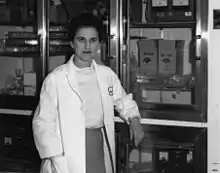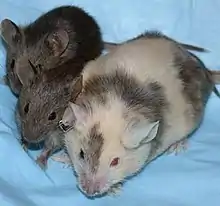Beatrice Mintz
Beatrice Mintz (born January 24, 1921)[1] is an American embryologist who has contributed to the understanding of genetic modification, cellular differentiation and cancer, particularly melanoma.[1][2] Mintz was a pioneer of genetic engineering techniques, and was among the first scientists to generate both chimeric and transgenic mammals.[2]
Beatrice Mintz | |
|---|---|
 | |
| Born | January 24, 1921 |
| Nationality | United States |
| Alma mater | Hunter College and University of Iowa |
| Known for | Mammalian transgenesis |
| Awards | Genetics Society of America Medal (1981) Ernst Jung Gold Medal for Medicine (1990) Pearl Meister Greengard Prize (2007) March of Dimes Prize in Developmental Biology Szent-Györgyi Prize for Progress in Cancer Research |
| Scientific career | |
| Fields | Embryology, Developmental biology |
| Institutions | University of Chicago Fox Chase Cancer Center |
| Doctoral advisor | Emil Witschi |
| Influenced | Rudolf Jaenisch |
In 1996 she shared the inaugural March of Dimes Prize in Developmental Biology with Ralph L. Brinster for their work in developing transgenic mice.[1] Much of her career has been spent at the Fox Chase Cancer Center in Philadelphia where, in 2002, she was named to the Jack Schultz Chair in Basic Science.[3] Mintz is a member of both the United States National Academy of Sciences and the Pontifical Academy of Sciences.
Early life and education
Beatrice Mintz was born in New York City to Samuel and Janie Stein Mintz, a Jewish couple from Mikulintsy, Austria, which was part of what was then called Galicia. She graduated magna cum laude from Hunter College in 1941[4] and then took graduate studies at New York University for a year. Because of anti Semitic admissions quotas in the colleges on the east coast, she attended the University of Iowa, where she received a master's degree in 1944 and a Ph.D. in 1946,[4] studying amphibians under Emil Witschi.[2]
Research

After graduation, Mintz accepted a Professorship in Biological Science at the University of Chicago[4] (1946–60;[4] interrupted by studies abroad: Mintz was awarded a Fulbright research fellowship at the universities of Paris and Strasbourg in 1951). In 1960 she moved to the Institute for Cancer Research of the Lankenau Hospital Research Institute, which became the Fox Chase Cancer Center in 1974, where she remains on faculty. In the mid 1950s, Mintz switched her research focus from amphibians to mammals and became a pioneer in mammalian transgenesis.[2] In 1965 she became an adjunct professor at the University of Pennsylvania.[4]
Mintz and Kristoph Tarkowski independently made the first mouse embryonic chimeras in the 1960s by aggregating two embryos at the eight-cell stage. The resultant mice developed normally and their tissues were a mixture of cells derived from the two donor embryos.[5] Mintz went on to create viable chimeric embryos containing blastomeres from up to fifteen different laboratory mice.[1] She developed a technique that involved mixing cells from a black mouse strain into the blastocysts of white or brown mice in vitro. She then surgically transferred these early embryos into surrogate mothers and, after birth, traced the tissue contribution of each cell type made by studying the coat colour.[6] Her cell fusion technique was successful where others had failed due to the choice to remove the zona pellucida with pronase treatment, rather than physically. Since 1967 Mintz has created over 25,000 offspring using this technique.[2]
Mintz also demonstrated that teratocarcinoma tumor cells could be reprogrammed to contribute to a healthy mouse when combined with normal mouse embryo cells[7] through eight years of experiments utilizing some of the first pluripotent stem cell cultures ever made.[3]
Mintz and Rudolf Jaenisch published a technological breakthrough in 1974. Jaenisch was a post-doctoral researcher in Princeton University at the time and was interested in why only certain types of cancer occurred when he injected adult mice with viruses. Inspired by Mintz's earlier work, he wanted to know whether injecting virus into early-stage embryos would result in the DNA being incorporated, and what types of cancer would occur.[8] Mintz agreed to work with Jaenisch, who joined her lab as a visiting fellow for 9 months. They showed that DNA from a virus, SV40, could be integrated into the DNA of developing mice and persist into adulthood without apparent tumor formation.[9] Although only somatic cells were affected, meaning the DNA would not be passed on to future generations, these were the first mice ever made with foreign DNA and this experiment proved healthy genetically modified mammals could be created by viral infection.[10] Using these techniques Mintz was able to establish the genetic basis of certain kinds of cancer and in 1993 she produced the first mouse model of human malignant melanoma.[1]
Honors
Mintz has received numerous awards and honors including the first Genetics Society of America Medal (1981)[11] and the first March of Dimes Prize in Developmental Biology shared with Ralph L. Brinster (1996).[1][3] She was elected a Fellow of the American Academy of Arts and Sciences (1982),[12] American Association for the Advancement of Science (1973) and wan an Honorary Fellow of the American Gynecological and Obstetrical Society since 1980.[13] She won the Papanicolaou Award for Scientific Achievement (1979), the Amory Prize (1988),[14] the Ernst Jung Gold Medal for Medicine (1990),[15] the John Scott Medal (1994),[16] the American Cancer Society National Medal of Honor for Basic Research (1997), a citation for Outstanding Woman in Science (1993) from the New York Academy of Sciences, and in 2007 she was a recipient of the Pearl Meister Greengard Prize.[17]
On March 8, 2011 the US National Foundation for Cancer Research had awarded Beatrice Mintz with its 6th Annual Szent-Gyorgyi Prize for Progress in Cancer Research.[18]
In 2012 Mintz was awarded with the Ninth Annual AACR Award for Lifetime Achievement in Cancer Research.[19]
Mintz has received honorary doctorate degrees from five universities. She has delivered dozens of special lectures, including the Ninetieth Anniversary Lecture at the Woods Hole Marine Biological Laboratory (1978) and the first Frontiers in Biomedical Sciences Lecture at the New York Academy of Sciences (1980). She is a member of the National Academy of Sciences, a senior member of the Institute for Cancer Research, Fox Chase Cancer Center, Philadelphia, and served on the editorial boards of various scientific journals.
References
- Volume 11 of Encyclopedia of World Biography, Gale Research, 1998, p. 49, ISBN 0-7876-2221-4
- Martha J. Bailey, American women in science: a biographical dictionary, Vol. 1, ABC-CLIO, 1994, p. 252, ISBN 0-87436-740-9
- Alumni Fellows, 2002 Recipients Archived November 20, 2009, at the Wayback Machine, The University of Iowa
- "Beatrice Mintz (b. 1921)". Science Service Records. Smithsonian Institution Archives. Retrieved February 6, 2019.
- Tam, P.P.; Rossant, J. (December 2003). "Mouse embryonic chimeras: tools for studying mammalian development". Development. 130 (25): 6155–63. doi:10.1242/dev.00893. PMID 14623817.
- Mintz, B. (1967). "Gene control of mammalian pigmentary differentiation. I. Clonal origin of melanocytes". Proc. Natl. Acad. Sci. USA. 58 (1): 344–351. doi:10.1073/pnas.58.1.344. PMC 335639. PMID 5231615.
- George Klein (April 2015). "Resisting Cancer". The Scientist.
- Brownlee, C (2004). "Biography of Rudolf Jaenisch". Proc. Natl. Acad. Sci. USA. 101 (31): 13982–84. doi:10.1073/pnas.0406416101. PMC 521108. PMID 15383657.
- Jaenisch R, Mintz B. (1974). "Simian Virus 40 DNA Sequences in DNA of Healthy Adult Mice Derived from Preimplantation Blastocysts Injected with Viral DNA". Proc. Natl. Acad. Sci. USA. 71 (4): 1250–4. doi:10.1073/pnas.71.4.1250. PMC 388203. PMID 4364530.
- Soriano P (1995). "Gene targeting in ES cells". Annu Rev Neurosci. 18: 1–18. doi:10.1146/annurev.ne.18.030195.000245. PMID 7605056.
- "The GSA Medal". Genetics Society of America. Archived from the original on July 15, 2015. Retrieved February 6, 2019.
- "Book of Members, 1780–2010: Chapter M" (PDF). American Academy of Arts and Sciences. Retrieved July 29, 2014.
- "Beatrice Mintz". Pontifical Academy of Sciences. Retrieved February 6, 2019.
- "Recipients of the Amory Prize". American Academy of Arts and Sciences. Archived from the original on January 16, 2018. Retrieved February 6, 2019.
- "Laureates 1990 to 2017". Archived from the original on February 9, 2019. Retrieved February 6, 2019.
- "City Of Philadelphia's John Scott Award Honors Cancer Researcher For 'Crazy Ideas'". The Scientist. December 12, 1994.
- "Three geneticists win 2007 Pearl Meister Greengard Prize". The Rockefeller University. March 25, 2008. Retrieved February 6, 2019.
- "Fox Chase Cancer Center's Beatrice Mintz, PhD, Receives the 6th Annual Szent-Györgyi Prize for Progress in Cancer Research". Fox Chase Center. March 8, 2011. Retrieved February 6, 2019.
- "Beatrice Mintz, PhD, Receives Ninth Annual AACR Award for Lifetime Achievement in Cancer Research". Fox Chase Center. March 27, 2012. Retrieved February 6, 2019.
External links
| Wikimedia Commons has media related to Beatrice Mintz. |
- Faculty profile, at the Fox Chase Cancer Center.
- Beatrice Mintz Biography @ answers.com
